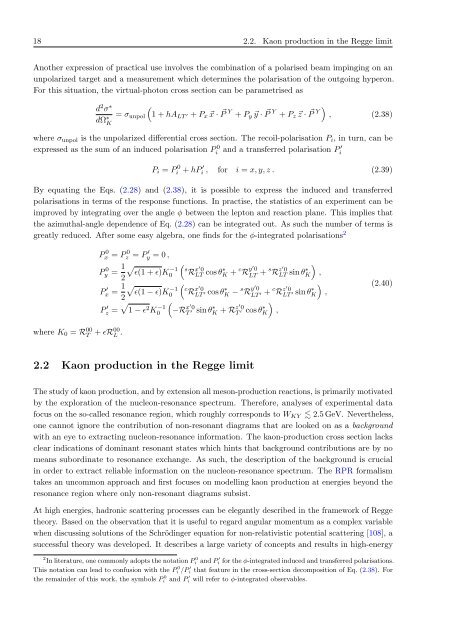Download Thesis in Pdf Format - Theoretical Nuclear Physics and ...
Download Thesis in Pdf Format - Theoretical Nuclear Physics and ...
Download Thesis in Pdf Format - Theoretical Nuclear Physics and ...
You also want an ePaper? Increase the reach of your titles
YUMPU automatically turns print PDFs into web optimized ePapers that Google loves.
18 2.2. Kaon production <strong>in</strong> the Regge limitAnother expression of practical use <strong>in</strong>volves the comb<strong>in</strong>ation of a polarised beam imp<strong>in</strong>g<strong>in</strong>g on anunpolarized target <strong>and</strong> a measurement which determ<strong>in</strong>es the polarisation of the outgo<strong>in</strong>g hyperon.For this situation, the virtual-photon cross section can be parametrised asd 2 σ ∗dΩ ∗ K= σ unpol(1 + hA LT ′ + P x ⃗x · ⃗P Y + P y ⃗y · ⃗P Y + P z ⃗z · ⃗P Y ) , (2.38)where σ unpol is the unpolarized differential cross section. The recoil-polarisation P i , <strong>in</strong> turn, can beexpressed as the sum of an <strong>in</strong>duced polarisation Pi 0 <strong>and</strong> a transferred polarisation P i′P i = P 0i + hP ′i , for i = x, y, z . (2.39)By equat<strong>in</strong>g the Eqs. (2.28) <strong>and</strong> (2.38), it is possible to express the <strong>in</strong>duced <strong>and</strong> transferredpolarisations <strong>in</strong> terms of the response functions. In practise, the statistics of an experiment can beimproved by <strong>in</strong>tegrat<strong>in</strong>g over the angle φ between the lepton <strong>and</strong> reaction plane. This implies thatthe azimuthal-angle dependence of Eq. (2.28) can be <strong>in</strong>tegrated out. As such the number of terms isgreatly reduced. After some easy algebra, one f<strong>in</strong>ds for the φ-<strong>in</strong>tegrated polarisations 2Px 0 = Pz 0 = P y ′ = 0 ,Py 0 = 1 √ɛ(1 + ɛ)K−102P x ′ = 1 √ɛ(1 − ɛ)K−102P ′ z = √ 1 − ɛ 2 K −10( )sR x′ 0LT cos θK ∗ + c R y′ 0LT + s R z′ 0LT s<strong>in</strong> θK∗ ,( )cR x′ 0LT ′ cos θ∗ K − s R y′ 0LT+ c R ′ z′ 0LT ′ s<strong>in</strong> θ∗ K ,)T ′ s<strong>in</strong> θ∗ K + R z′ 0T ′ cos θ∗ K ,(−R x′ 0(2.40)where K 0 = R 00T+ ɛR00 L .2.2 Kaon production <strong>in</strong> the Regge limitThe study of kaon production, <strong>and</strong> by extension all meson-production reactions, is primarily motivatedby the exploration of the nucleon-resonance spectrum. Therefore, analyses of experimental datafocus on the so-called resonance region, which roughly corresponds to W KY 2.5 GeV. Nevertheless,one cannot ignore the contribution of non-resonant diagrams that are looked on as a backgroundwith an eye to extract<strong>in</strong>g nucleon-resonance <strong>in</strong>formation. The kaon-production cross section lacksclear <strong>in</strong>dications of dom<strong>in</strong>ant resonant states which h<strong>in</strong>ts that background contributions are by nomeans subord<strong>in</strong>ate to resonance exchange. As such, the description of the background is crucial<strong>in</strong> order to extract reliable <strong>in</strong>formation on the nucleon-resonance spectrum. The RPR formalismtakes an uncommon approach <strong>and</strong> first focuses on modell<strong>in</strong>g kaon production at energies beyond theresonance region where only non-resonant diagrams subsist.At high energies, hadronic scatter<strong>in</strong>g processes can be elegantly described <strong>in</strong> the framework of Reggetheory. Based on the observation that it is useful to regard angular momentum as a complex variablewhen discuss<strong>in</strong>g solutions of the Schröd<strong>in</strong>ger equation for non-relativistic potential scatter<strong>in</strong>g [108], asuccessful theory was developed. It describes a large variety of concepts <strong>and</strong> results <strong>in</strong> high-energy2 In literature, one commonly adopts the notation Pi 0 <strong>and</strong> P i ′ for the φ-<strong>in</strong>tegrated <strong>in</strong>duced <strong>and</strong> transferred polarisations.This notation can lead to confusion with the Pi 0 /P i ′ that feature <strong>in</strong> the cross-section decomposition of Eq. (2.38). Forthe rema<strong>in</strong>der of this work, the symbols Pi0 <strong>and</strong> P i ′ will refer to φ-<strong>in</strong>tegrated observables.















